Family Activities in Nepal
Historically, Nepal's strategic location on the ancient Silk Road facilitated cultural and trade exchanges with China, India, and Tibet, enriching its historical and cultural legacy.
Historically, Nepal's strategic location on the ancient Silk Road facilitated cultural and trade exchanges with China, India, and Tibet, enriching its historical and cultural legacy.

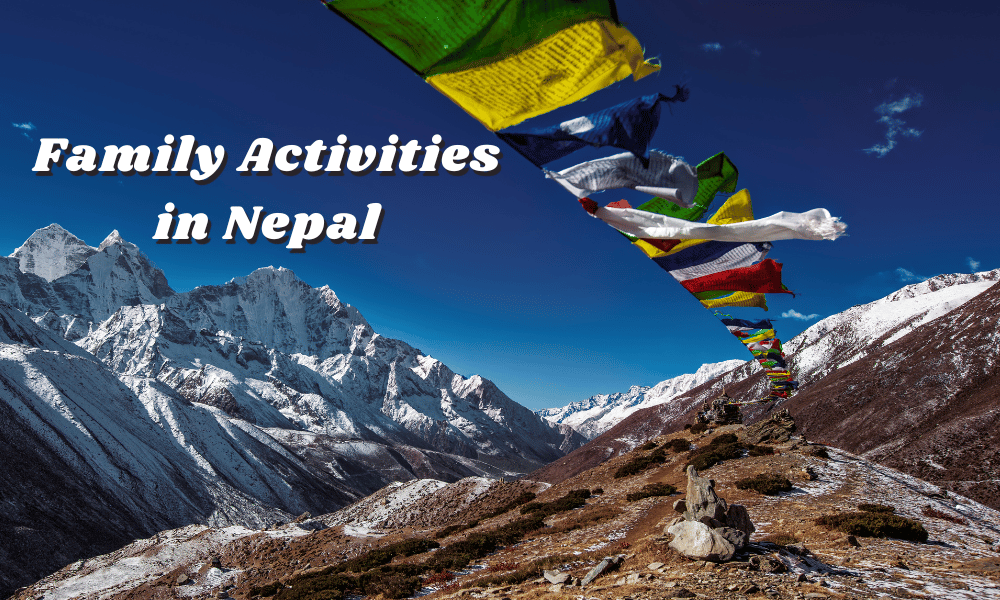
Nepal is a landlocked country nestled in the heart of the Himalayas in South Asia. Known for its striking geographic diversity, Nepal's terrain varies from the lofty, snowy peaks of Mount Everest, the highest point on earth, to the lush, tropical lowlands of Terai. This rich geography harbors an incredible range of biodiversity, adding to the country's unique allure.
The cultural tapestry of Nepal is as diverse and vibrant as its landscape. Home to a multitude of ethnic groups, including the Newar, Sherpa, Tharu, Tamang, Gurung, and many others, Nepal is a melting pot of customs, languages, and traditions. It is a predominantly Hindu country but also shelters a significant Buddhist population, most notably in Lumbini, the birthplace of Lord Buddha. The intricate blend of Hinduism and Buddhism gives rise to numerous festivals celebrated with gusto throughout the year.
Historically, Nepal's strategic location on the ancient Silk Road facilitated cultural and trade exchanges with China, India, and Tibet, enriching its historical and cultural legacy. The Kathmandu Valley, in particular, is a testament to this rich history, dotted with medieval temples, old palaces, and UNESCO World Heritage Sites that exhibit a blend of Hindu and Buddhist artistic expression.
However, beyond the grandeur of the Himalayas and the charisma of its culture, it's the warm, hospitable people of Nepal that truly leave a lasting impression on visitors. The Nepali adage 'Atithi Devo Bhava' (Guests are God) captures the spirit of Nepalese hospitality that greets every visitor. Whether you're a thrill-seeking adventurer or a curious culture explorer, Nepal offers a fascinating journey like no other.
Traveling as a family can be a transformative experience. It not only allows us to explore new places and cultures but also strengthens our bonds through shared experiences and memories. When it comes to destinations that offer myriad experiences, Nepal is a treasure trove. The country's distinctive blend of thrilling outdoor adventures, rich cultural heritage, and friendly locals make it an ideal destination for an unforgettable family getaway.
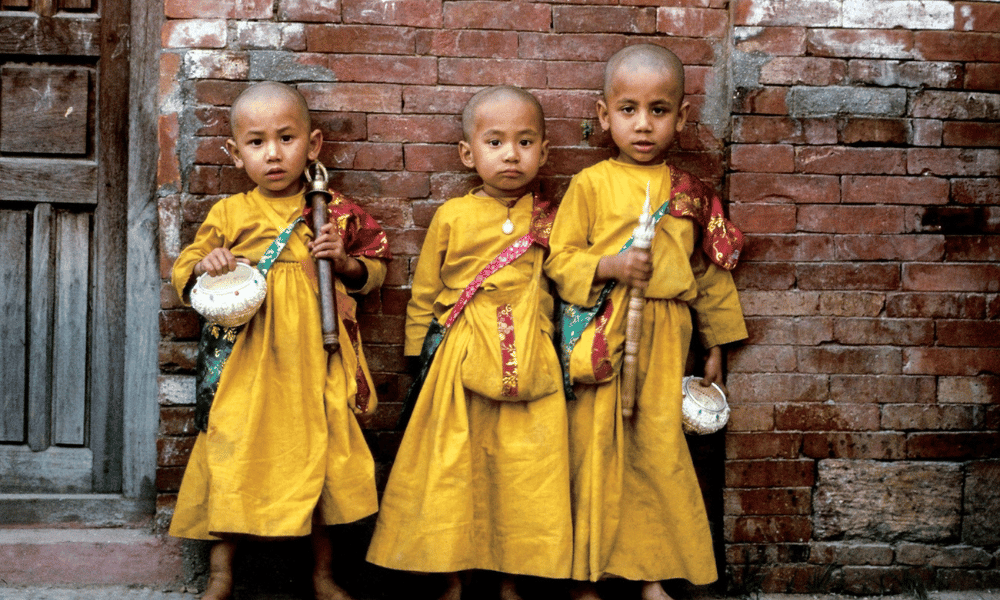
Nepal’s diversity in terms of geography and culture lends itself to a multitude of activities suitable for families. This means there's something to keep every family member engaged, be it the awe-inspiring natural landscapes for nature lovers, adrenaline-pumping adventures for thrill-seekers, or immersive cultural experiences for those who love to delve into history and tradition.
For families that love outdoor adventures, Nepal's landscapes offer unparalleled opportunities. You can embark on family-friendly treks that navigate through verdant valleys, terraced fields, and traditional mountain villages. If you're up for a little excitement, consider a jungle safari in the Terai region, where you'll come face to face with exotic wildlife like one-horned rhinos and Bengal tigers. Or, opt for a gentle river rafting trip, enjoying Nepal's beautiful riverscape while also catering to your adventurous side.
For families interested in culture and history, Nepal's cities and towns are filled with historical landmarks and vibrant cultural traditions. Kathmandu Valley alone boasts seven UNESCO World Heritage Sites, and wandering through the ancient squares and temples will transport you back in time. Participating in a local festival or trying your hand at a cooking class can provide your family with an authentic taste of Nepalese life.
Ultimately, a trip to Nepal is an invitation to leave the familiar behind and step into a world where family adventures await at every turn. It's an opportunity for families to grow together, learn together, and create memories that will last a lifetime.
When it comes to planning a trip to a diverse and multifaceted country like Nepal, the question often arises: should we focus more on outdoor adventures or cultural exploration? The truth is, both outdoor adventures and cultural exploration offer their unique experiences and benefits. Your preference between the two may depend on your interests, physical abilities, and what you want to gain from the trip.
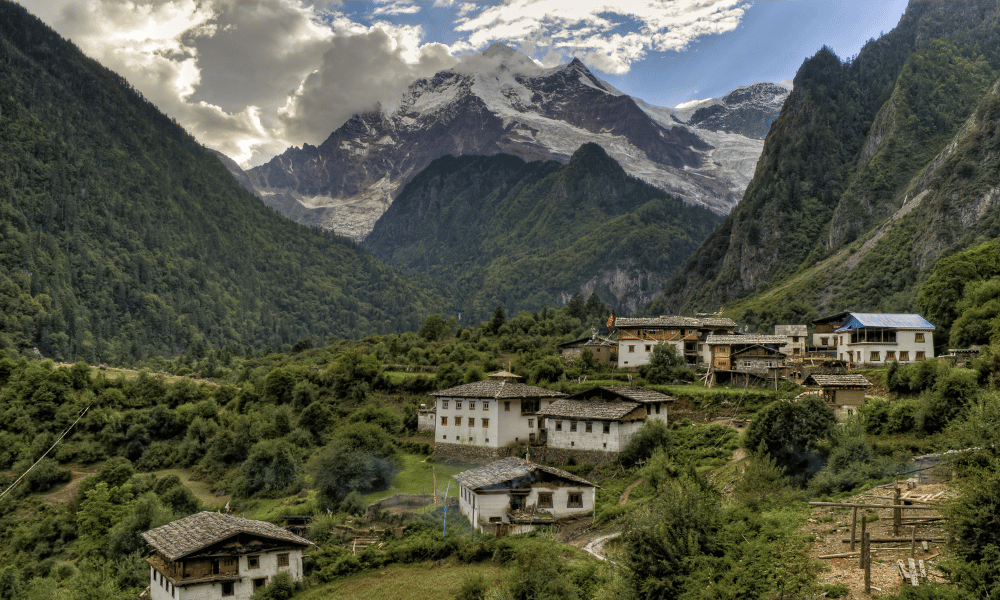
Outdoor adventures in Nepal often involve activities like trekking, jungle safaris, river rafting, mountain biking, and wildlife viewing. These activities offer the thrill of adventure, physical exercise, and a chance to immerse yourself in Nepal's stunning natural landscapes.
The benefits of outdoor adventures include:
Physical Fitness: Activities like trekking and rafting are great for maintaining physical health and fitness. They can also be a fun way to introduce children to the benefits of physical activity.
Connection with Nature: Outdoor adventures offer an unparalleled opportunity to connect with nature. Experiencing the beauty of the Himalayas firsthand or spotting exotic wildlife can foster a love for nature and a greater understanding of the importance of conservation.
Teamwork and Resilience: Many outdoor activities require teamwork, which can strengthen family bonds. Overcoming challenges during these adventures can also build resilience and confidence, especially in children.
Cultural exploration in Nepal could involve visiting historic landmarks and UNESCO World Heritage Sites, participating in local festivals, engaging in a cooking class, or staying with a local family as part of a homestay experience. These activities provide a deep understanding of Nepal's rich history, diverse cultures, and unique traditions.
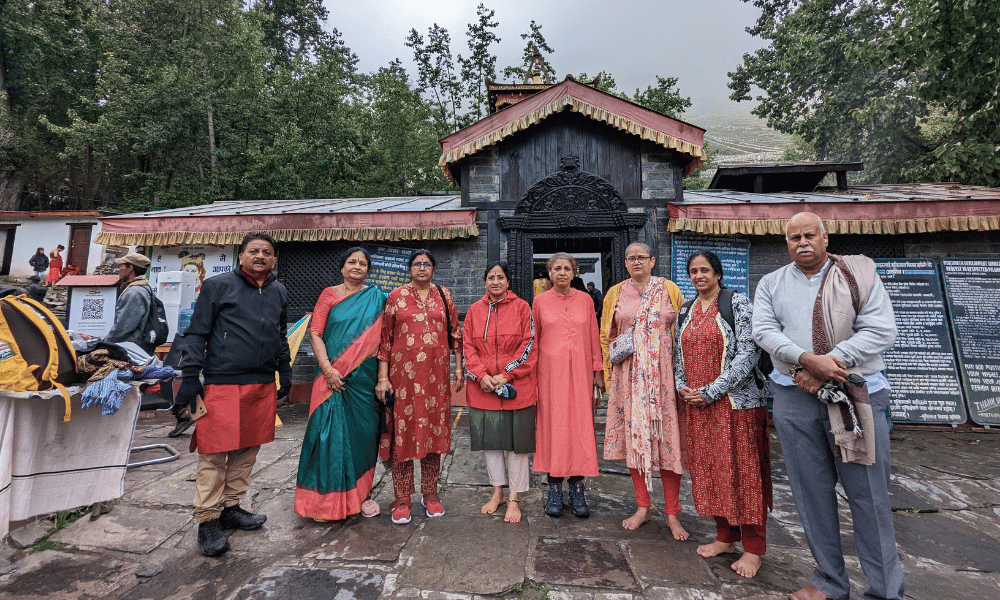
The benefits of cultural exploration include:
Cultural Appreciation: Visiting historical sites, attending local festivals, and interacting with local communities can enhance appreciation and understanding of different cultures. This can foster a sense of global citizenship, especially in children.
Educational: Cultural exploration can be very educational. It offers a hands-on learning experience about the history, traditions, and lifestyle of the people in Nepal.
Authentic Experiences: Cultural exploration often leads to unique, authentic experiences that are not typically part of the regular tourist trail. These experiences can make your trip more meaningful and memorable.
In reality, the best approach might be a balance of both. Nepal offers the opportunity to combine outdoor adventures with cultural exploration, allowing you to enjoy the best of both worlds. This combination can create a more holistic and enriching travel experience, offering physical challenges, personal growth, and a deeper understanding and appreciation of the country's cultural heritage.
Trekking in Nepal is more than just an outdoor activity; it's a journey into the heart of the country's unparalleled natural beauty and an integral part of the Nepalese experience. With its lush valleys, quaint mountain villages, and majestic Himalayan peaks, Nepal offers some of the best trekking opportunities in the world. Whether you're an experienced trekker or a novice, there's a route here for you. And the best part? Many of these treks are family-friendly, making them an ideal choice for an adventurous family vacation.
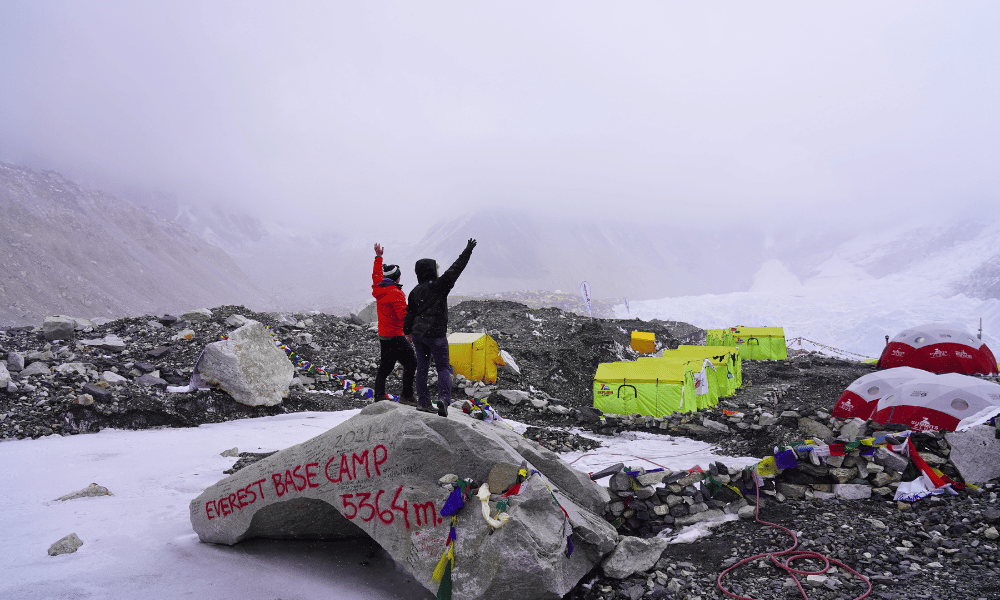
One of the most popular family-friendly treks in Nepal is the Ghorepani Poon Hill Trek. A relatively short and easy trek in the Annapurna region, it offers stunning mountain vistas, rhododendron forests, and a glimpse into the culture of the local Gurung and Magar communities. The highlight of the trek is a sunrise view from Poon Hill, where you can see a panoramic view of the Annapurna and Dhaulagiri ranges in all their glory.
The Langtang Valley Trek is another excellent option for families. Often referred to as 'the valley of glaciers', Langtang offers beautiful landscapes, and unique Tamang culture, and is less crowded compared to other trekking routes. The trek is moderately challenging, making it suitable for families with older children who have a decent level of fitness.
When trekking with children, safety, and preparation are paramount. Here are some key considerations:
Preparation: Make sure every family member is physically prepared for the trek. Regular walks or hikes at home can be a good way to build stamina.
Altitude: Be aware of the symptoms of altitude sickness, which can include headaches, nausea, and dizziness. Plan your itinerary to allow for gradual ascent and acclimatization.
Packing: Pack light, but ensure you have all the essentials, including good hiking shoes, warm clothing, a first-aid kit, water purification tablets, and high-energy snacks. Don't forget to bring sunscreen and hats for protection from the sun.
Guides and Porters: Consider hiring a local guide and porter. A guide can help you navigate the route and understand the local culture, while a porter can carry heavier bags, making the trek easier, especially for children.
Insurance: Ensure you have appropriate travel insurance that covers trekking activities.
Trekking in Nepal can be an unforgettable experience for your family. Not only does it provide an opportunity to witness the country's breathtaking natural beauty, but it also instills a sense of achievement and a deeper appreciation for nature in young minds.
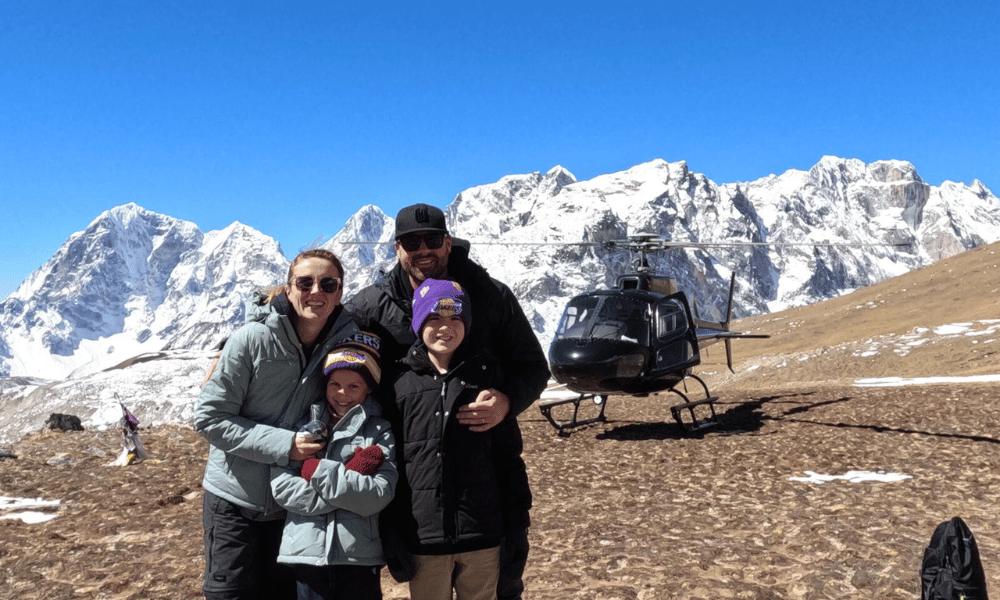
From the towering peaks of the Himalayas to the dense jungles of the Terai lowlands, Nepal's geographical diversity is truly remarkable. This contrast is nowhere more evident than in the country's wildlife-rich national parks. Offering a stark contrast to the snow-clad mountains, a jungle safari in Nepal provides an exciting opportunity for families to encounter unique wildlife and immerse themselves in nature.
Chitwan National Park, a UNESCO World Heritage Site located in the Terai region, is one of the best places in Nepal for a jungle safari. Known for its rich biodiversity, the park is home to the elusive Bengal tiger, one-horned rhinoceros, deer, leopards, sloth bears, and over 500 species of birds. A safari in Chitwan is an adventure the whole family will remember.
A typical day on a jungle safari in Chitwan starts early in the morning. You might find yourself floating down the Rapti River on a traditional dugout canoe, watching crocodiles basking in the sun or spotting a variety of bird species. This would be followed by a guided jungle walk where you can track animals by their footprints and droppings.
In the afternoon, you could embark on an exciting jeep safari through the heart of the park, where you can spot rhinos grazing in the grasslands, deer darting through the undergrowth, and if you're lucky, a tiger lurking in the shadows. The day would usually end with a cultural performance by the local Tharu community, providing a glimpse into their unique culture and traditions.
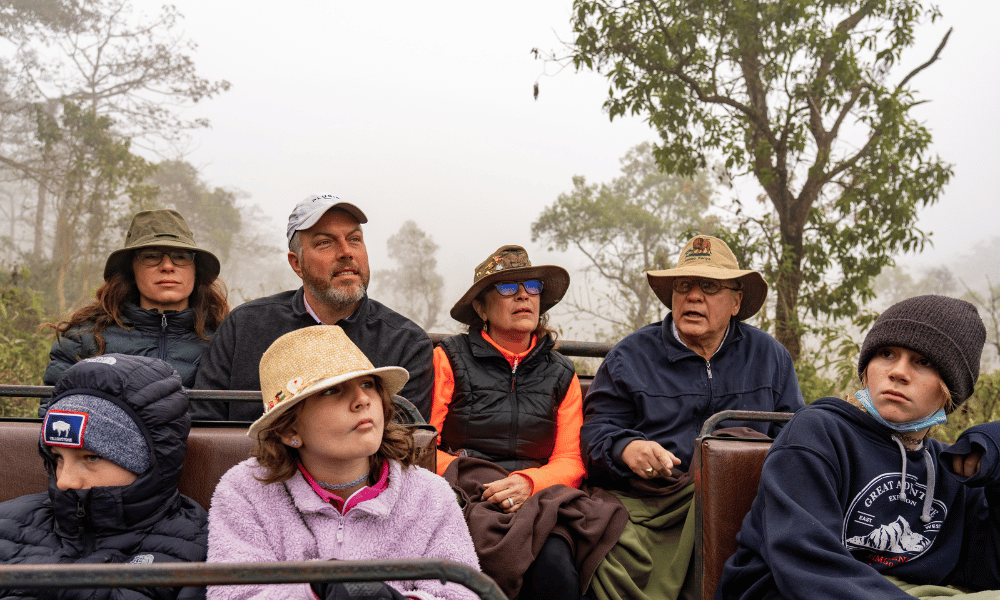
When going on a jungle safari, it's essential to prioritize safety and adhere to responsible tourism practices. Here are a few tips:
Guidance: Always stay with your guide. They are trained to understand animal behavior and keep you safe.
Noise: Keep noise to a minimum to avoid disturbing wildlife.
Distance: Maintain a safe distance from all wildlife. Remember, you are in their home.
Litter: Carry a bag to store your trash. It's crucial to leave the park as pristine as you found it.
Clothing: Wear comfortable clothing and footwear suitable for walking. Earth-tone clothes are recommended to blend in with the environment.
Insect Repellent: Bring a good insect repellent to protect against mosquito bites.
Respect: Respect the local culture and traditions. The national park is an integral part of the surrounding communities' livelihoods and cultural identity.
A jungle safari in Nepal is a thrilling and educational experience for children and adults alike. By observing animals in their natural habitat and learning about biodiversity and conservation, families can deepen their appreciation for wildlife and our shared responsibility to protect it.
One of Nepal's unique adventure offerings is river rafting. Blessed with a multitude of snow-fed rivers cascading down through stunning landscapes, Nepal is a haven for white-water enthusiasts. But don't let the 'white-water' part intimidate you – Nepal offers rafting experiences for all ages and abilities, including families with children.
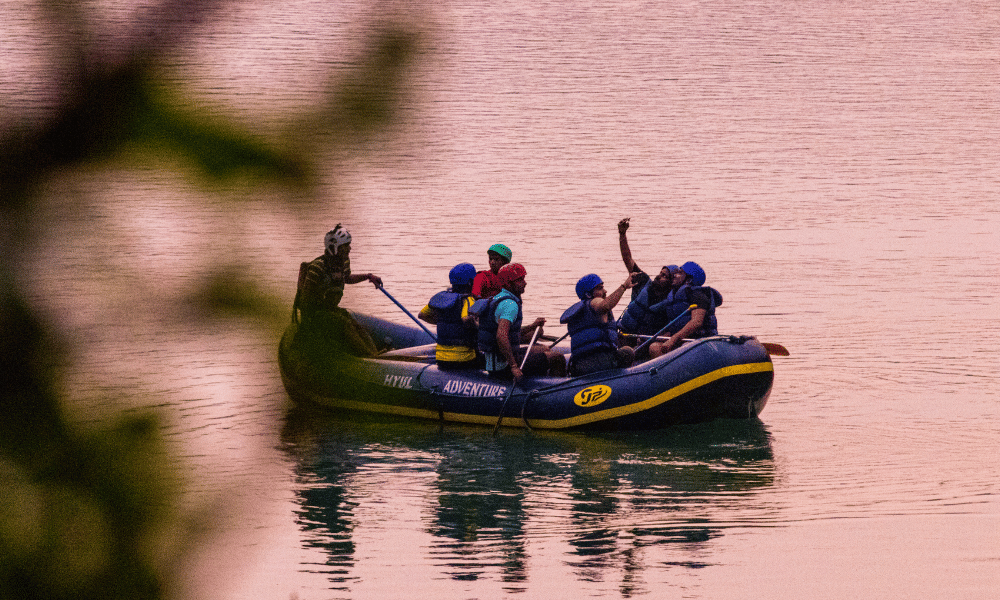
A prime example of family-friendly rafting in Nepal is on the Trisuli River. The Trisuli, with its easy accessibility from Kathmandu and Pokhara and a perfect mix of serene stretches and mild rapids, offers an ideal rafting experience for families. During the journey, you'll be surrounded by beautiful scenery, including lush forests, traditional Nepali villages, and terraced fields, while navigating the gentle but exhilarating rapids of the river.
When planning a river rafting trip with children, safety should always be your top priority. Here are some key considerations:
Professional Guides: Always opt for a reputable rafting company with experienced guides. They should be trained in first aid and rescue operations and know the river's course well.
Safety Gear: Make sure everyone in the family is equipped with the proper safety gear, including life jackets, helmets, and suitable footwear. The rafting company should provide these.
Briefing: Pay attention to the safety briefing before you set off. It's essential to know what to do in case of a fall or if the raft capsizes.
Swimming Ability: While you don't need to be an excellent swimmer to go rafting, basic swimming skills are beneficial. If anyone in the family can't swim, make sure to inform the guide.
Age Limit: Check the age limit for children. Most rafting companies in Nepal permit children over the age of eight to raft, but this can vary depending on the river and its current conditions.
River rafting in Nepal is a thrilling experience that adds a dash of adventure to your family vacation. It offers an opportunity to work together as a team, overcome challenges, and most importantly, have a lot of fun. Remember, the goal is to create memorable experiences and enjoy the natural beauty that surrounds you.
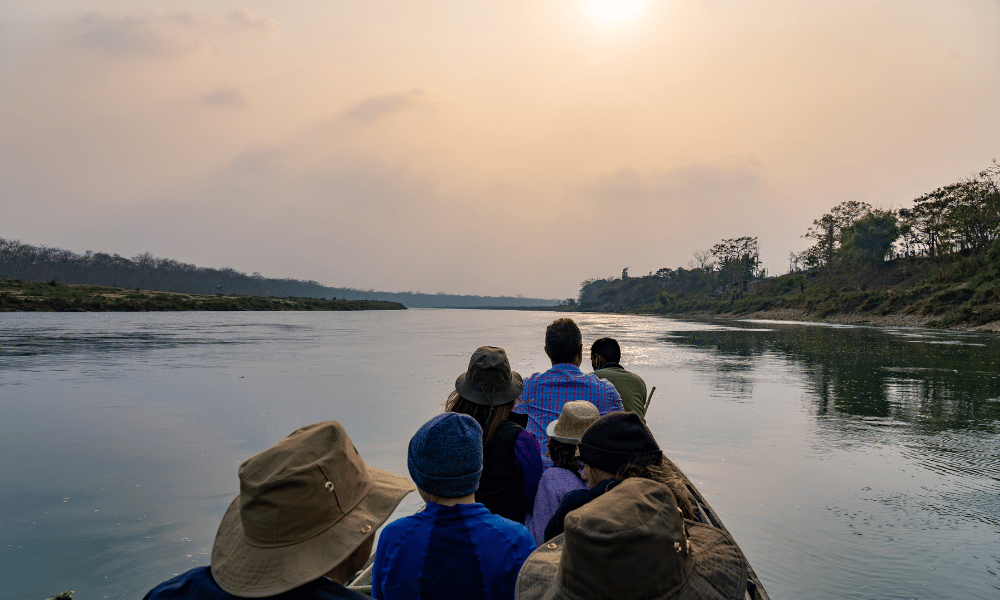
Nepal's rich cultural heritage is reflected in its numerous UNESCO World Heritage Sites, most of which are concentrated in the Kathmandu Valley. Visiting these historical landmarks offers families an excellent opportunity to explore Nepal's history and cultural traditions, providing an enriching learning experience for both adults and children.
Kathmandu Durbar Square: Located at the heart of the city, Kathmandu Durbar Square is a lively open-air museum filled with historical monuments, palaces, and temples. As you wander around the square, you'll be stepping back in time, to when Kathmandu was a vibrant royal city. Children will be fascinated by the intricate wood carvings on the buildings, especially on the iconic Kasthamandap, said to have been constructed from a single tree.
Pashupatinath Temple: One of the most sacred Hindu temples in the world, the Pashupatinath Temple complex is a fascinating place to observe religious rituals and ceremonies. Though only Hindus are allowed inside the main temple, the surrounding complex offers plenty to see, from the cremation ghats along the Bagmati River to the richly adorned smaller temples and shrines.
Boudhanath Stupa: A visit to the Boudhanath Stupa, one of the largest spherical stupas in Nepal, offers insight into Tibetan Buddhist culture. The colorful prayer flags fluttering in the wind and the gentle hum of Buddhist chants create a peaceful atmosphere. Children will enjoy watching the devotees circumambulating the stupa and spinning prayer wheels, activities they can join in, too.
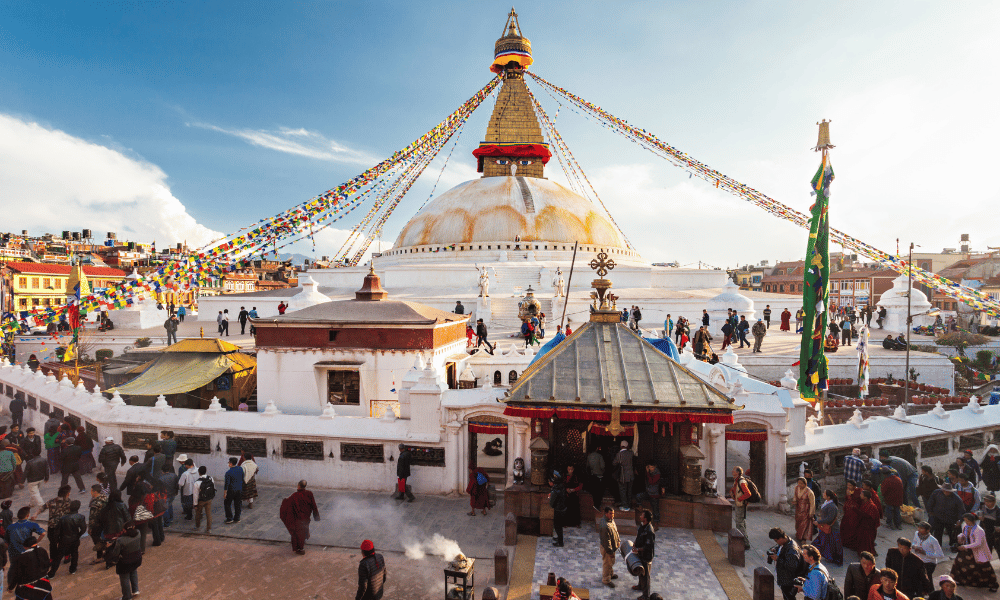
When exploring these World Heritage Sites, engage your children in activities that will make their visit more interactive and enjoyable. This could involve a scavenger hunt to spot different architectural elements, sketching their favorite monument, or trying to capture the best photograph. Encourage them to ask questions and share their observations.
It's also important to discuss respectful behavior when visiting these sites. Teach them about the cultural significance of the places they are visiting, the importance of not touching delicate structures, and the appropriate behavior in places of worship.
Exploring Nepal's UNESCO World Heritage Sites provides a valuable educational experience for families, enhancing their understanding of the country's cultural heritage and historical context. It also fosters a sense of respect for different cultures and traditions, making it a rewarding experience for the entire family.
Nepalese cuisine, much like the country itself, is a delightful amalgamation of flavors and influences. It reflects the diverse cultures, ethnicities, and geographic variations of Nepal. Exploring this cuisine not only tantalizes the taste buds but also offers a gastronomic gateway to understanding Nepalese culture.
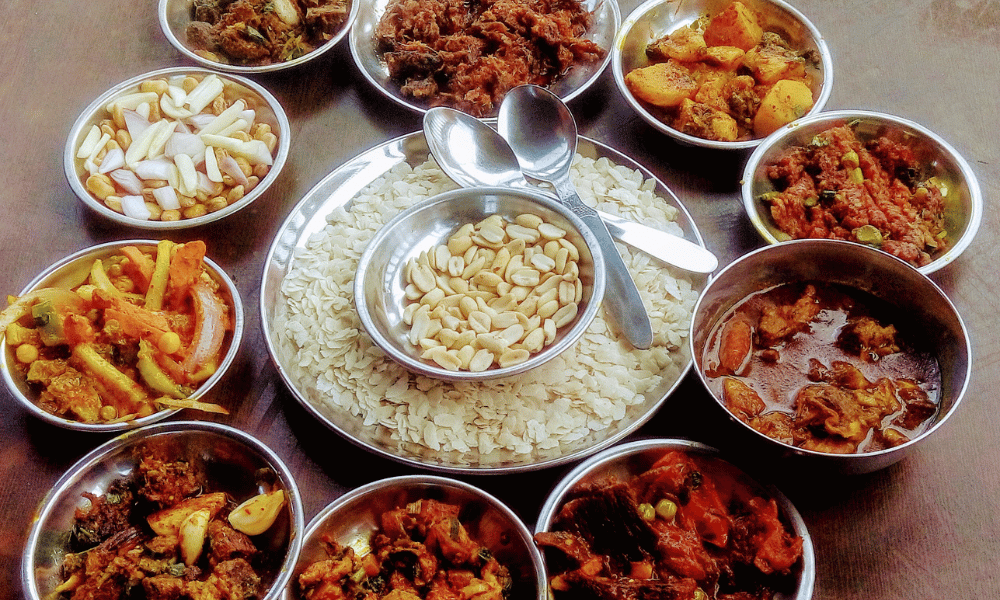
A fun and engaging way for families to dive into the local culinary scene is by participating in cooking classes or food tours. A cooking class provides a hands-on experience, where you can learn to prepare traditional Nepalese dishes under the guidance of local experts. This could be an unforgettable activity for children, who can enjoy the process of cooking and take pride in the dishes they help create. Food tours, on the other hand, offer a chance to explore local markets, taste a variety of street foods, and learn about the culinary history of Nepal.
When it comes to Nepalese cuisine, here are some must try unique Nepalese dishes for your family:
Dal Bhat: This is a staple meal in Nepal, comprising lentil soup (dal), rice (bhat), and accompanied by vegetable curry, pickles, and sometimes meat. Each region has its variation, offering a new flavor at every turn.
Momo: Momos are Nepalese dumplings filled with minced meat or vegetables, steamed to perfection. They are usually served with a spicy tomato-based dipping sauce.
Gundruk: A fermented leafy green dish, gundruk is a unique Nepalese delicacy. It's often served as a side dish or made into a soup.
Juju Dhau: Also known as the 'King of Yogurts,' this creamy, rich yogurt is a specialty of Bhaktapur. It's often served as a dessert and is loved by children.
Remember, when trying new foods, it's important to be mindful of hygiene and food safety, particularly with street food. Opt for freshly cooked, hot foods and ensure that any raw foods like fruits and vegetables can be peeled before eating.
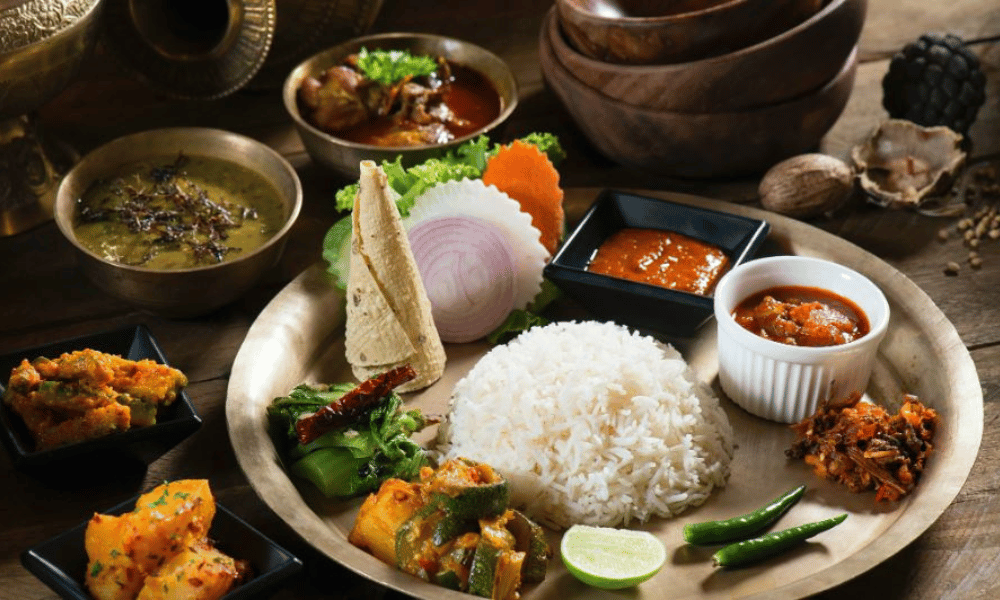
Exploring the local cuisine is an essential part of experiencing a new culture. It exposes children to different flavors and food practices, expanding their palates and their understanding of the world.
Festivals hold a special place in the cultural landscape of Nepal, reflecting the country's rich cultural diversity and religious heritage. Celebrating these festivals offers an exciting opportunity for families to immerse themselves in Nepalese culture and tradition.
Dashain: The biggest and most auspicious festival in Nepal, Dashain, is a 15-day-long celebration that marks the victory of good over evil. It takes place in late September or early October, depending on the lunar calendar. During Dashain, families come together to feast and exchange blessings and gifts. Children fly kites, a popular Dashain activity symbolizing the connection between earth and heaven. Visitors can join in the festivities by witnessing the various rituals, playing traditional games, and tasting special Dashain dishes.
Tihar: Often referred to as the festival of lights, Tihar is a five-day festival celebrated in October or November. Each day is dedicated to honoring different beings, such as crows, dogs, cows, and even siblings. Families decorate their homes with oil lamps and colorful designs called Rangoli, creating a vibrant and festive atmosphere. One of the highlights of Tihar is the tradition of Deusi-Bhailo, where groups go door-to-door singing and dancing, much like Carol singing during Christmas.
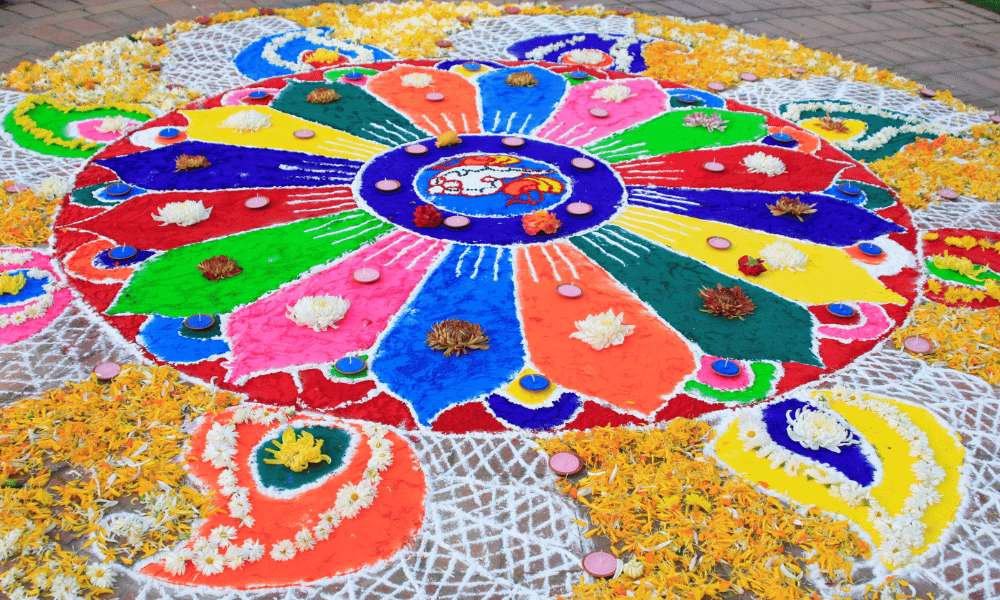
Holi: Known as the festival of colors, Holi is a joyous celebration that takes place in March, marking the arrival of spring. During Holi, people throw colored powders and water at each other, signifying the vibrancy of spring and the victory of good over evil. It's a fun-filled festival that children particularly enjoy. As a visitor, you're more than welcome to join in the color-throwing. Just make sure to wear clothes that you don't mind getting stained.
Before participating in any festival, it's important to understand the customs and traditions associated with it. Always show respect for local practices, and when in doubt, feel free to ask locals for guidance.
Experiencing Nepalese festivals can be a fun and immersive way to understand the country's cultural nuances. These celebrations, marked by rituals, music, dance, and food, provide a colorful snapshot of Nepal's rich cultural tapestry and are sure to create lasting memories for the whole family.
Finding the right accommodation is a key aspect of planning a memorable family vacation. Luckily, Nepal offers a range of options to cater to various preferences and budgets. From luxury hotels and cozy homestays to eco-lodges, there's something for every family.
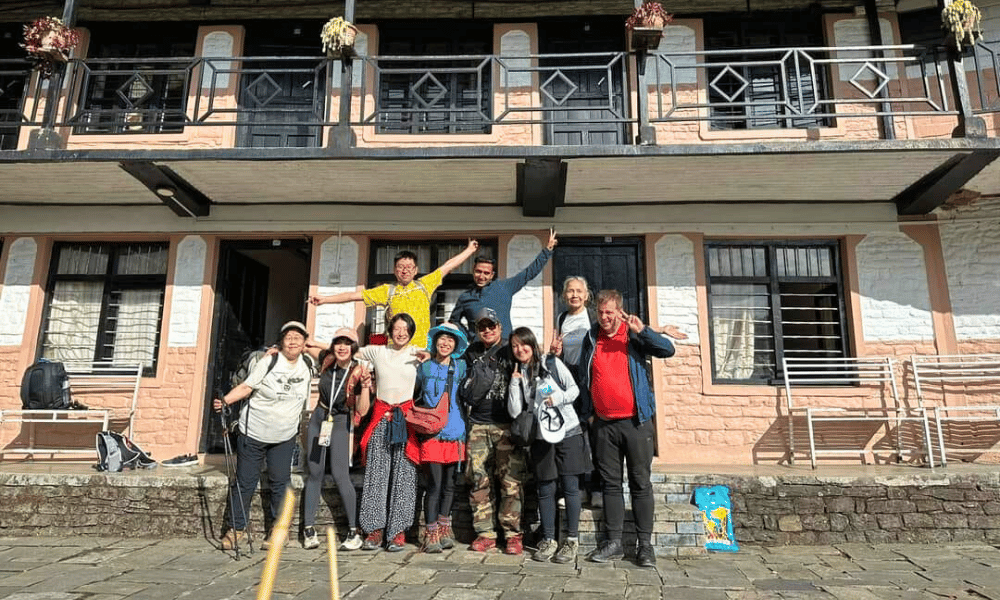
Luxury Hotels: If you prefer a comfortable and hassle-free stay with all the modern amenities, consider booking a luxury hotel. Major cities like Kathmandu and Pokhara offer a variety of high-end hotels known for their excellent service and comfort. These hotels often provide family-friendly amenities, such as interconnecting rooms, child-friendly menus, babysitting services, and recreational activities tailored for kids.
Homestays: For a more immersive experience, consider a homestay, where you live with a local family. This provides an intimate glimpse into Nepalese lifestyle and traditions, making your trip more meaningful. Homestays are especially popular in rural areas and can range from basic to quite comfortable, so you can choose one based on your comfort level and preference.
Eco-Lodges: If you are a nature-loving family, staying at an eco-lodge can be a delightful experience. These accommodations, usually found around national parks and conservation areas, offer an opportunity to stay close to nature without compromising on comfort. Eco-lodges often offer guided tours and nature-related activities, making them an excellent choice for families keen on exploring Nepal's natural wonders.
When selecting accommodation, consider the following factors:
Location: Choose a location that is convenient and safe. If you plan to explore a specific area extensively, look for accommodations nearby. In cities, staying close to major attractions can save travel time.
Amenities: Look for family-friendly amenities. These may include a kitchenette for preparing kids' meals, laundry facilities, or a playground. Some places may offer cribs or extra beds for children.
Budget: Set a budget for your accommodation and try to stick to it. Remember, expensive doesn't always mean better, especially when there are so many unique and affordable places to stay in Nepal.
Reviews: Always check reviews before booking. Past guests' experiences can give you a fair idea of what to expect.
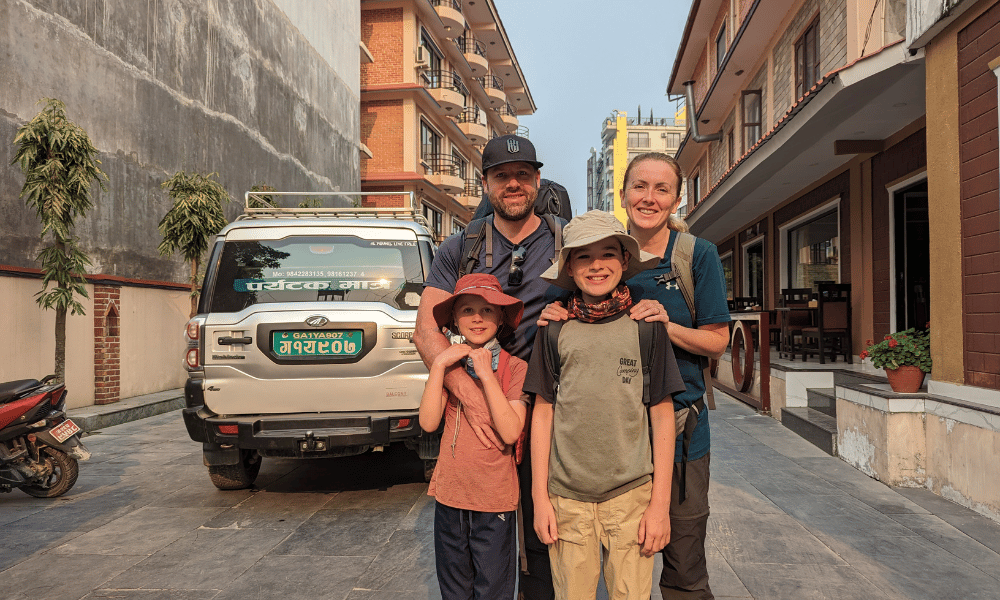
Choosing the right accommodation can significantly enhance your family's travel experience. Whether you're looking for luxury, cultural immersion, or a nature-centric stay, Nepal has it all. With some research and planning, you're sure to find the perfect place that your entire family will love.
Nepal, with its spectacular landscapes, rich culture, and warm hospitality, offers a wealth of experiences that can make your family vacation truly unforgettable. Whether you choose to challenge yourselves with a scenic trek, immerse in the thrill of a jungle safari, feel the rush of river rafting, delve into the historical charm of UNESCO World Heritage Sites, savor the diverse Nepalese cuisine, or participate in the colorful festivals, there's something for everyone in the family.
This journey through Nepal not only promises adventure and learning but also fosters a sense of appreciation for nature and different cultures, values that are important for children as they grow. The comfort of diverse accommodations adds to the overall experience, making the trip more enjoyable and relaxed.
Every moment spent in Nepal is likely to become a cherished memory, a story to be shared again and again. This beautiful country invites you to step out of your everyday lives and step into an experience that's as enriching as it is exciting.
So, if you're contemplating where to head for your next family trip, look no further. Nepal, in all its majestic glory, awaits you. Come, explore, and create unforgettable memories in this beautiful corner of the world.
Yes, Nepal is generally considered safe for a family vacation. Nepalese people are known for their warm hospitality and are very welcoming to children. However, like in any other country, it's important to take regular safety precautions, like avoiding remote areas at night and safeguarding your valuables.
The best time to visit Nepal depends on the activities you're interested in. For trekking, the most popular seasons are spring (March to May) and autumn (September to November) when the weather is favorable and the mountain views are clear. For cultural sightseeing, Nepal can be visited all year round, although the summer monsoon season (June to August) can make travel more challenging due to heavy rain.
Yes, certain treks are suitable for children, especially the ones that are less strenuous and at lower altitudes. Treks like Ghorepani Poon Hill and Langtang Valley are popular choices for families. However, it's important to prepare well and consider the fitness level of your children. Always ensure your children are well-equipped and take regular breaks to avoid exhaustion.
Ensure your kids are up-to-date on routine vaccines and consult with a healthcare provider for any additional vaccines recommended for travel to Nepal. Always carry essential medications and a first-aid kit. When trying local food, prioritize places that maintain good hygiene to avoid any potential stomach issues. During outdoor activities, ensure your kids are protected from the sun and stay hydrated.
Packing for Nepal should depend on the activities you plan to undertake and the time of the year. For trekking, pack good hiking shoes, warm clothing, rain gear, hats, and sunscreen. Casual and comfortable clothes are fine for sightseeing. If you're traveling with young children, consider packing any specialty food items they may require since they might not be available in Nepal.
Yes, most Nepalese festivals welcome participation from visitors. It's a great way for your family to engage with the local culture. However, remember to respect local customs and traditions while participating.
Nepal offers a range of accommodations suitable for families, from luxury hotels and guest houses in the cities to eco-lodges and teahouses in rural areas. Many places offer family rooms and other child-friendly amenities. Always check the facilities and reviews before booking.